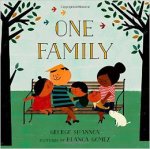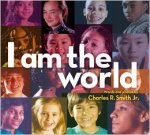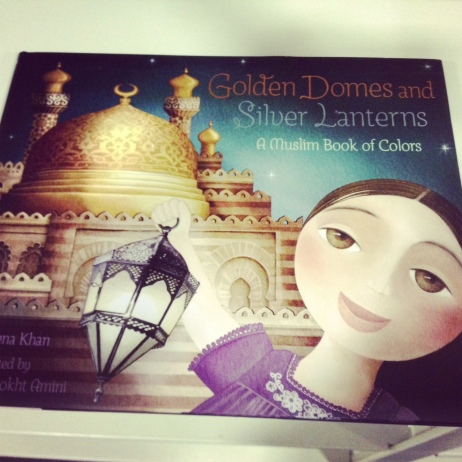Every document that comes home from my daughter’s elementary school comes in three different languages: English, Spanish, and Somali. In the hallways, you can see various languages on signs and posters. Her school isn’t a language immersion school; it’s just a typical school in Minneapolis. According to the school district, there are 96 languages or dialects spoken by students or their families throughout the city, and her school is only 31% white.
Our kids are growing up in a world in which you can’t count on the people around you speaking your language. You might have to meet people somewhere between your language and theirs or listen for more than just the meaning of words.
 I was thinking about this as I read Gabi, A Girl in Pieces by Isabel Quintero, which is written in journal format and includes a lot of Spanish words and phrases throughout the book. Gabi’s life is in both languages, and it feels real to have both languages represented in her journal. I don’t speak Spanish, but I loved Gabi’s story. I connected with her through her intimate and humorous diary entries as she sorted out big issues like cultural identity, family problems, and feminism all while discovering the power of poetry. It’s a story that will stick with me for a long time. Sure, I didn’t always know the Spanish words, but I did know Gabi.
I was thinking about this as I read Gabi, A Girl in Pieces by Isabel Quintero, which is written in journal format and includes a lot of Spanish words and phrases throughout the book. Gabi’s life is in both languages, and it feels real to have both languages represented in her journal. I don’t speak Spanish, but I loved Gabi’s story. I connected with her through her intimate and humorous diary entries as she sorted out big issues like cultural identity, family problems, and feminism all while discovering the power of poetry. It’s a story that will stick with me for a long time. Sure, I didn’t always know the Spanish words, but I did know Gabi.
At the AWP Conference in Minneapolis in 2015, I attended a session in which M. Evelina Galang spoke about her book Angel de la Luna and the 5th Glorious Mystery, and she shared her experience that young people never seemed to question the inclusion of Tagalog in her book the way adult readers did. The teen readers accepted that it was part of the story and created their own context around it. Galang advises readers in a post you can download on her web site to “feel the words” they don’t understand. In her book, Galang creates a rich world full of feeling that will give readers an opportunity to connect with Angel’s experience whether they know any Tagalog or not.
 My daughter, a third-grader, is far from reading these teen novels, but she could “feel the words” in Juana & Lucas by Juana Medina, which includes lots of Spanish words in the text as the story follows a young Colombian girl as she learns English. Juana is a wonderfully likable character, and it is easy to relate to her even with a limited knowledge of Spanish. Her story is just the thing to generate enthusiasm for learning a new language!
My daughter, a third-grader, is far from reading these teen novels, but she could “feel the words” in Juana & Lucas by Juana Medina, which includes lots of Spanish words in the text as the story follows a young Colombian girl as she learns English. Juana is a wonderfully likable character, and it is easy to relate to her even with a limited knowledge of Spanish. Her story is just the thing to generate enthusiasm for learning a new language!
 I also made sure to share I’m New Here by Anne Sibley O’Brien with her last year when a new student arrived in her class. The student had only recently arrived in the country from Somalia and spoke very little English, much like Fatimah in the book. I’m New Here helped us to talk about how it would feel to go to school in a different country and explore how we might connect with people when we don’t share a language. This conversation could easily be had in a classroom setting, and teachers may be interested in the resources available on O’Brien’s web site, including a community event kit and a video. Pair it with Meg Medina’s Mango, Abuela, and Me for the way the story blends English and Spanish as grandmother and granddaughter attempt to communicate despite not speaking each other’s language.
I also made sure to share I’m New Here by Anne Sibley O’Brien with her last year when a new student arrived in her class. The student had only recently arrived in the country from Somalia and spoke very little English, much like Fatimah in the book. I’m New Here helped us to talk about how it would feel to go to school in a different country and explore how we might connect with people when we don’t share a language. This conversation could easily be had in a classroom setting, and teachers may be interested in the resources available on O’Brien’s web site, including a community event kit and a video. Pair it with Meg Medina’s Mango, Abuela, and Me for the way the story blends English and Spanish as grandmother and granddaughter attempt to communicate despite not speaking each other’s language.
These are the books that reflect the world in which we live, and I hope to see even more cultures and languages (especially Somali!) represented on the shelves of our libraries to help us remember that there are ways to connect with people and things we share with them even when we don’t share a first language.







 It’s about listening and humility.
It’s about listening and humility.









